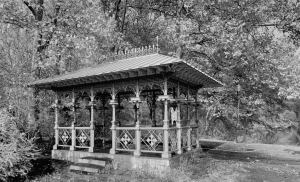
Pavilion from HAER Survey, Courtesy Library of Congress
It may be a bit odd to consider now, but before the 1960s raised concerns about security, waiting rooms, hotel lobbies and department store lounges were commonplace.
Some were for the public, others intended for “ladies” were common in New York City. Department stores like Lord & Taylor and B. Altman on 5th Avenue, had lounges for women to recover and re-energize while shopping. Hotels like the Endicott on Columbus Avenue and 81st Street had lobbies and palm courts where you could read a book or newspaper while waiting for an appointment in the neighborhood, or meet a friend over a cocktail seated in a comfortable velvet club chair or wicker settee. At least one waiting room lobby, notably at the Waldorf Astoria, was also a tourist attraction. This was in part at least because of its stunning 4-faced clock. Made of gilded bronze, the clock was not only elaborately ornamented, but in keeping with what was then innovative technology: it was electrified. The clock was commissioned by Queen Victoria as a gift to the United States, and showcased at the 1893 Columbian Exposition in Chicago. Purchased by John Jacob Astor, it was placed at the original Waldorf Astoria. Later it was re-installed in the Waldorf on Park Avenue gaining “Meet me at the clock” fame. This clock even “spent time” on the Upper West Side when it was temporarily installed at the New- York Historical Society, waiting to be returned to the Waldorf Astoria once renovations to the hotel are complete.
Grand Central Terminal featured huge high ceilinged waiting rooms for travelers, and Harlem’s 125th Street Metro North station was distinctively wood paneled. The 72nd Street station on the elevated lines famously photographed by Berenice Abbott on 72nd Street and Columbus Avenue had a potbelly stove heating the waiting room.
While utilitarian metal seating protected by plexiglass shelters are currently available at many bus stops, they offer none of the aesthetic pleasure and comfort of some late 19th Century and early-mid 20th century waiting rooms.
The Upper West Side notably still has a remarkable Victorian outdoor waiting room” made from cast iron, slate, wood, and stone” according to the Parks Department website. Fancifully designed by Jacob Wrey Mould, it was constructed in 1872 at the corner of 58th Street and 8th Avenue. Called the ladies pavilion it was specifically intended for women to wait for carriages or trollies to other parts of the city after they had enjoyed some hours in Central Park. Located in the area where the USS Maine National Monument was constructed in 1913, the ladies pavilion was moved to an area on the western shore of the lake around 75th Street. This spot may have been chosen because it offers an exhilarating view of the park looking south, but also because the site had earlier been used for the Ladies Cottage, a structure that accommodated women to put on skates to go ice skating on that that part of the lake “ladies skating pond” when it froze in winter. The floor of the Ladies Pavilion was made of stones used in the earlier structure.
The parks department and others have valued a distinctively turquoise- painted ladies pavilion that it restored with great care and use of more durable materials in 1973 and again in 1983. Fitted with several benches today, it’s an inviting spot to enjoy the view, rest, lace up, or wait for a friend to join a walk in the park.
